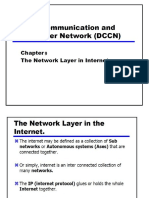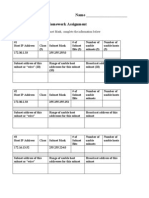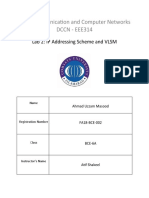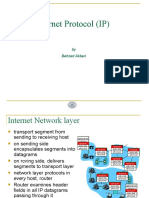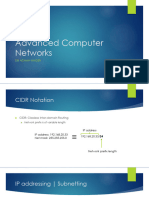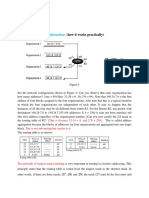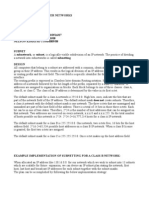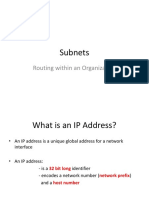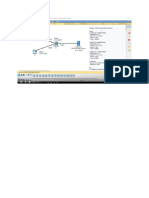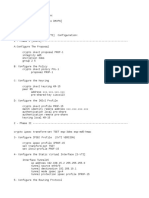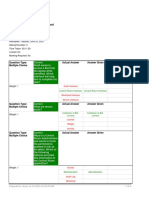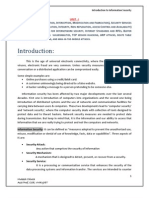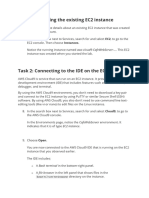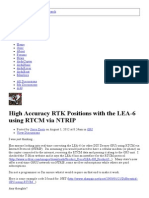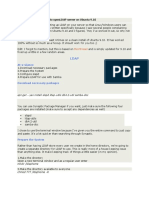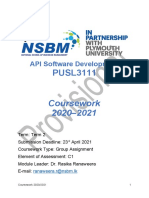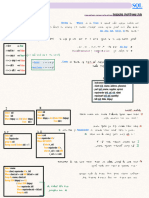Assignment 9
P12. Prefix Link Interface
200.23.16.0/21 0
200.23.24.0/24 1
200.23.24.0/21 2
Otherwise 3
P13. Prefix Link Interface
224.0/10 0
224.64/16 1
224/8 2
225.128/9 3
Otherwise 3
P14.
Any IP address in range 128.119.40.128 to 128.119.40.191
Four equal size subnets: 128.119.40.64/28, 128.119.40.80/28, 128.119.40.96/28,
128.119.40.112/28
P19.
a.
Since all IP packets are sent outside, so we can use a packet sniffer to record all IP
packets generated by the hosts behind a NAT. As each host generates a sequence of IP
packets with sequential numbers and a distinct (very likely, as they are randomly
chosen from a large space) initial identification number (ID), we can group IP packets
with consecutive IDs into a cluster. The number of clusters is the number of hosts
behind the NAT.
For more practical algorithms, see the following papers.
“A Technique for Counting NATted Hosts”, by Steven M. Bellovin, appeared in IMW’02,
Nov. 6-8, 2002, Marseille, France.
“Exploiting the IPID field to infer network path and end-system characteristics.”
Weifeng Chen, Yong Huang, Bruno F. Ribeiro, Kyoungwon Suh, Honggang Zhang,
Edmundo de Souza e Silva, Jim Kurose, and Don Towsley.
PAM'05 Workshop, March 31 - April 01, 2005. Boston, MA, USA.
b.
However, if those identification numbers are not sequentially assigned but randomly
assigned, the technique suggested in part (a) won’t work, as there won’t be clusters in
sniffed data.
�P21.
S2 flow table
Match Action
Ingress Port: 1; IP Src: 10.3.*.*; IP Dst: Forward(2)
10.1.*.*
Ingress Port: 2; IP Src: 10.1.*.*; IP Dst: Forward(1)
10.3.*.*
Ingress Port: 1; IP Dst: 10.2.0.3 Forward(3)
Ingress Port: 2; IP Dst: 10.2.0.3 Forward(3)
Ingress Port: 1; IP Dst: 10.2.0.4 Forward(4)
Ingress Port: 2; IP Dst: 10.2.0.4 Forward(4)
Ingress Port: 3 Forward(4)
Ingress Port: 4 Forward(3)
P24.
Match Action
IP Src = 10.1.0.1; IP Dst = 10.2.0.3 Forward (3)
IP Src = 10.1.0.1; IP Dst = 10.2.0.4 Forward (4)
IP Src = 10.3.0.6; IP Dst = 10.2.0.3 Forward (3)
IP Src = 10.3.0.6; IP Dst = 10.2.0.4 Forward (4)
Match Action
IP Dst = 10.2.0.3; port = TCP Forward (3)
IP Dst = 10.2.0.4; port = TCP Forward (4)
Match Action
IP Dst = 10.2.0.3 Forward (3)
Match Action
IP Src = 10.1.0.1; IP Dst = 10.2.0.3; port = Forward (3)
UDP
Classroom questions:
1. What is the subnet address if the destination address is 200.45.34.56 and the
subnet
mask is 255.255.240.0?
- 11001000 00101101 00100010 00111000
- 11111111 11111111 11110000 00000000
- —------------------------------------------------------
- 11001000 00101101 00100000 00000000
Convert to decimal
- 200.45.32.0
�2. Stevens is granted site address 181.56.0.0. Stevens needs 1000 subnets.
Design it. Give the first 5 subnets and the last 5 subnets.
No. of 1s in default mask = 16, class B
No. of subnets needed = 1000 = 2^10 - 24 = 10
No. of 1s in subnet mask = 16 + 10 = 26
Subnet mask = 255.255.255.192 = 126
No. of 0s in subnet mask = 32 - 26 = 6
No. of subnets = 1024
No. of addresses in each subnet = 2^6 = 64 (0 to 63)
1st Subnet:
First Address: 181.56.0.0
Last Address: 181.56.0.63
2nd Subnet:
First Address: 181.56.0.64
Last Address: 181.56.0.127
3rd Subnet:
First Address: 181.56.0.128
Last Address: 181.56.0.191
4th Subnet:
First Address: 181.56.0.192
Last Address: 181.56.0.255
5th Subnet:
First Address: 181.56.1.0
Last Address: 181.56.1.63
...
996th Subnet:
First Address: 181.56.248.192
Last Address: 181.56.248.255
997th Subnet:
First Address: 181.56.249.0
Last Address: 181.56.249.63
998th Subnet:
First Address: 181.56.249.64
Last Address: 181.56.249.127
999th Subnet:
First Address: 181.56.249.128
Last Address: 181.56.249.191
1000th Subnet:
First Address: 181.56.249.192
Last Address: 181.56.249.255
...
� 1020th Subnet:
First Address: 181.56.254.192
Last Address: 181.56.254.255
1021st Subnet:
First Address: 181.56.255.0
Last Address: 181.56.255.63
1022nd Subnet:
First Address: 181.56.255.64
Last Address: 181.56.255.127
1023rd Subnet:
First Address: 181.56.255.128
Last Address: 181.56.255.191
1024th Subnet:
First Address: 181.56.255.192
Last Address: 181.56.255.255





